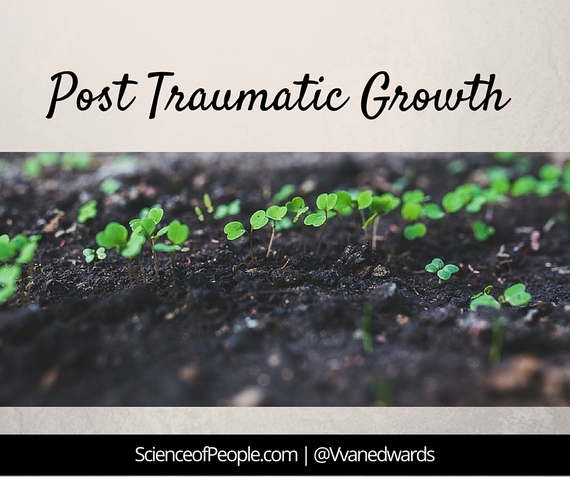Scar tissue is stronger than regular tissue.
Our wounds, our failures and our challenges eventually heal. And if we're lucky, we become stronger because of them. Today I want to make sure:
- You heal stronger.
- You don't bounce back, you bounce forward.
- You recover better.
What do we do when bad things happen to good people? Failures, challenges and mistakes... they happen to the best of us. I want to introduce you to a completely new way of thinking about the bad things that happened to us. Specifically, this is a concept called:
Post Traumatic Growth: (PTG) The positive mental shift experienced as a result of adversity.
We hear a lot about the devastating effects of PTSD or Post Traumatic Stress Disorder, but researchers Richard Tedeschi and Lawrence Calhoun discovered an interesting phenomenon that can happen after someone experiences a trauma. They found that people often report ways in which their psychological functioning increases after they have experienced a challenge. In other words, in certain circumstances, our mind can grow from difficulty.
Tedeschi found that across a wide range of negative experiences, as many as 90% of survivors report at least one Post Traumatic Growth benefit.
Life After Trauma
I want to be really clear on something: PTG does not imply that trauma is not destructive and challenging. And it does not say that victims should be able to simply bounce back to 'normal' life after adversity. Rather, PTG evidence shows us that over time people can reap benefits from their adversity.
Post Traumatic Growth holds a very important idea:
We don't bounce back from challenges, we bounce forward.
Post Traumatic Growth Areas:
There are some specific areas that researchers have found change after adversity.
1. Relationships
Some victims of trauma describe that they come to value their friends and family more deeply after a trauma and don't take people for granted as much as before their adversity. Challenges can also give us an increased sense of compassion and longing for more intimate relationships. In other words, adversity can reinvigorate our relationships and give us new priorities for the people in our life.
- Thought Challenge: Who helped you get through trauma?
- Thought Challenge: If you experienced adversity, did you seek out more close connections afterwards?
2. Self-Esteem
While some might think that experiencing trauma might make you feel like a victim, many people find that their challenge gave them deeper inner wisdom, personal strength and gratitude. Trauma can even help people be more accepting of their vulnerabilities and limitations.
- Thought Challenge: What did you learn about yourself or the world after your adversity
3. Meaning
Trauma can radically change and re-engineer people's life perspective. Often times, adversity causes individuals to reevaluate their life purpose and mission, becoming less materialistic and more able to live in the present.
- Thought Challenge: What do you want to do with your life?
- Thought Challenge: Why do you think you are on this Earth right now, at this time?
From Trauma to Post Traumatic Growth
If you have experienced a trauma or major adversity and you want to begin to bounce forward, there are a few elements that are known to contribute to Post Traumatic Growth.
Step One: Feel Deep
Don't diminish your response to the adversity itself. You have to go through a difficult emotional processing period before bouncing forward. You can think of this like grief--you have to be able to mourn and feel before moving on. Don't be afraid of exploring the pain and sadness of your challenge as a natural part of adversity.
Step Two: Constructive Self-Disclosure
Researchers have found that we have to share and talk about our adversity to process it fully. They call this constructive self-disclosure. Bottling up any trauma often leads to a worsening of symptoms. Find a safe group or confidant where you can share your story and the effects of your challenge.
Step Three: Personal Strengths
Look at how your personal strengths got you through the trauma. How did you handle it and what have you learned from the experience? Your number one personal strength is that nothing can stop you. Right now you are reading this article, which means you are surviving and you are moving towards recovery.
You don't bounce back, you bounce forward.
I hope that this message reaches you and anyone who needs it.
If you know someone who might need to see this article, please send it their way with a hug from us.

